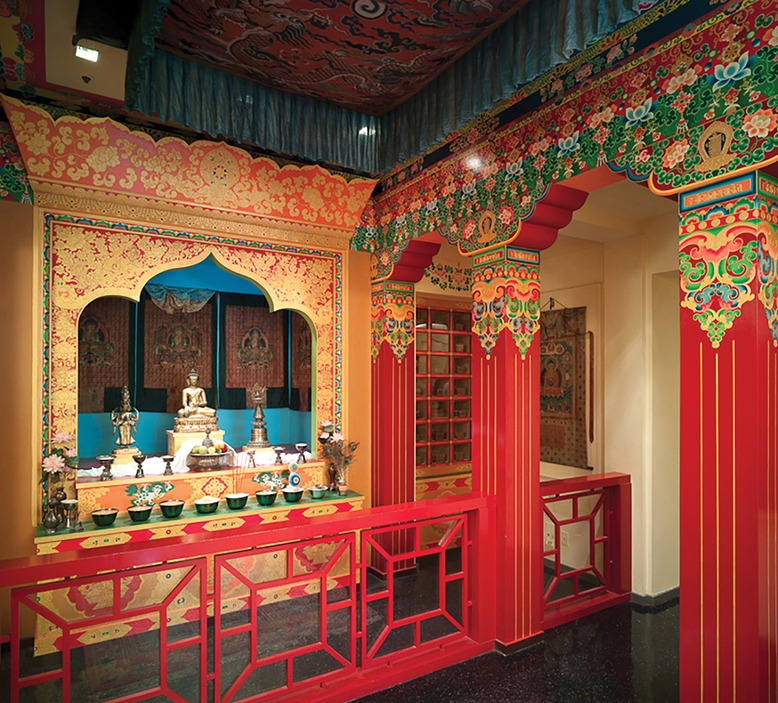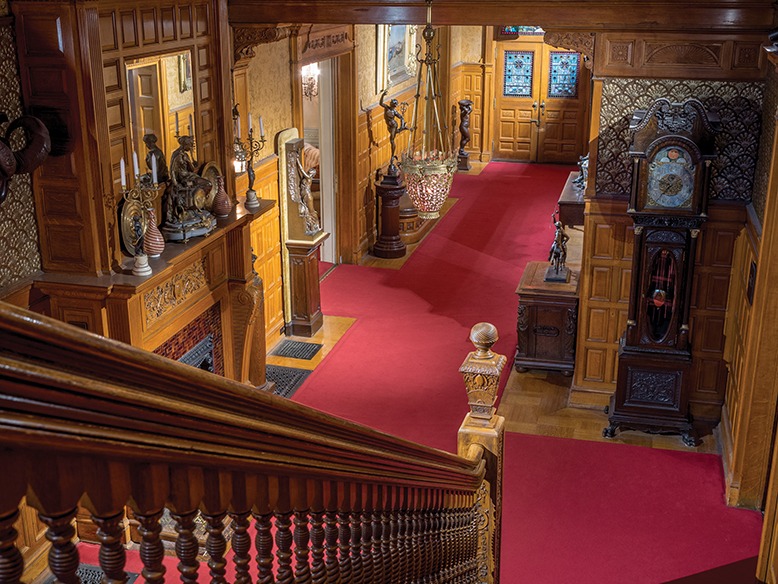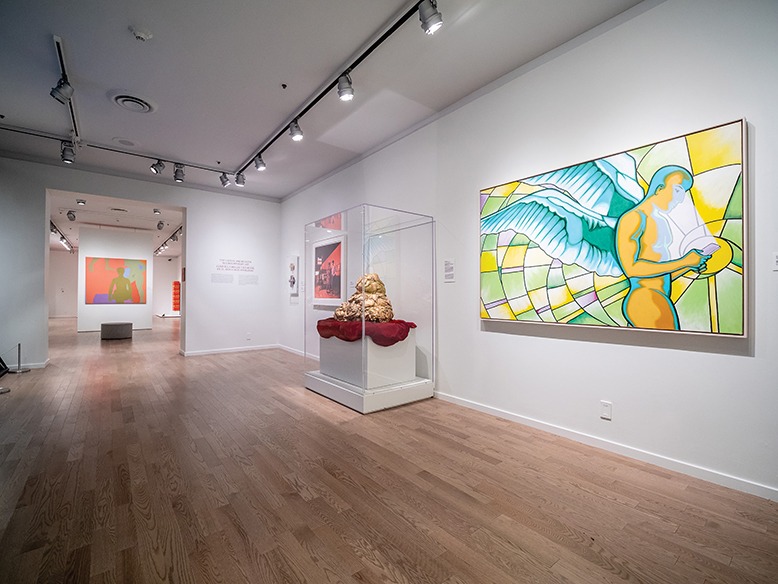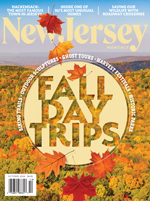
A huge grin stretches across Linda Harrison’s face. A few dozen children from Newark’s Wilson Avenue School, dressed in matching yellow polos, surround her as she stands on the steps of Engelhard Court in the heart of what’s been known as the Newark Museum. The song Celebration by Jersey City’s Kool & the Gang blasts over the loudspeakers. Harrison pumps her arms and shouts “Whoop, whoop, whoop!”
There is definitely cause for celebration. On this November day, the 110-year-old institution on Washington Street officially launches a new era under a new name: the Newark Museum of Art.
The unveiling follows a two-year project to refresh the museum’s identity. In February 2018, an independent study commissioned by the museum found that 50 percent of people who were aware of the institution but had not visited described it as either a history museum or a museum about the city of Newark, or they simply didn’t know what the museum offered. During the rebranding process, Harrison came on board as director and CEO, with bold plans to eliminate those misconceptions and promote the nonprofit museum’s strongest asset: its collection of 130,000 works of art, ranging from Colonial-era portraits to contemporary mixed-media pieces.
The museum’s holdings include Asian, African and American art, as well as a science collection totaling 150,000 objects. Only about 3 to 5 percent of the collections are on view at a given time. Always in evidence are the restored Ballantine House, an attached Victorian mansion that serves as gallery space; and a Tibetan Buddhist altar that the Dalai Lama consecrated.
“It’s really a nationally and internationally respected collection, but it’s not well known within the city or state so much,” says Clifford Blanchard, a trustee of the museum since 2011 and a cochairman of the board for the past three years.

On the third floor, visitors will find an ornate Tibetan Buddhist altar. Photo courtesy of the Newark Museum of Art
Harrison’s leadership marks a new beginning for the museum, the state’s largest. One year ago this month, she became the fifth woman to lead the institution. She’s continuing the legacy of women, such as Mary Sue Sweeney Price, who worked for 18 years in the museum’s public relations department and for 20 years as director before retiring in 2013.
Sweeney Price, who is now an emerita board member, hopes the museum can “be recognized as a wonderful experience artistically, aesthetically, intellectually,” she says. “There’s a lot that goes into acquainting people with that, and I commend Linda and the staff and the trustees for all the work they are doing.”
Harrison—the museum’s first African-American leader, and one of five African-American directors currently leading major museums across the country—has a reputation as a museum visionary. She has more than 20 years of leadership experience in the for-profit and nonprofit worlds. (Harrison is reluctant to reveal her age, but admits she’s “old enough to have worn bell-bottoms in 1978 to a Chaka Khan and Rufus concert in Chicago.”)
[RELATED: The Stunning Debut of New Brunswick Performing Arts Center]
As director and CEO of the Museum of the African Diaspora in San Francisco’s Yerba Buena arts district, Harrison worked to change the institution from a history-focused museum to one known for contemporary art. Within her first 18 months, she redesigned the museum, doubling the number of galleries. Museum attendance rose 25 percent. Over the course of her five-year tenure, Harrison also increased fundraising by 60 percent.
“I helped to transform that museum into a cultural hub and an anchor for the city of San Francisco,” says Harrison. “I’ve seen that model and how exciting it was there, and I thought Newark is poised for this similar type of transformation.”
A graduate of Chicago’s Loyola University, Harrison also brings to the table her experience in business development with companies such as Eastman Kodak and Sotheby’s International. “When you’re developing a new market, you’ve got to be sensitive to, what is the community looking for? What are we hearing? Those are tools that [I brought] into the nonprofit world.”
Harrison’s experience and charisma impressed the hiring committee, says Blanchard. (Sweeney Price’s successor, Steven Kern, left the museum in 2017 after a brief tenure.) “The Newark Museum of Art was in a position that something had to radically shift to make it more relevant,” says Blanchard. “We didn’t feel that we were getting all the traction with the community we could. We wanted a candidate that resonated with the community and shared a perspective that we thought was needed.”

The restored Ballantine House, an attached Victorian mansion, houses the museum’s permanent collection of decorative arts. Photo courtesy of the Newark Museum of Art
Harrison grew up on the South Side of Chicago, in Hyde Park. “It’s now known as Obamaland,” she says. When she was young, the city implemented busing in an effort to desegregate the schools. “I was required to change schools, and it changed my life,” says Harrison. “My new route included walking through the University of Chicago to get to William H. Ray School, [which] was integrated. It blew my mind, that I had access to nice classrooms, lunch, and exposure to a host of cultural institutions.” Her first school field trip was to the Art Institute of Chicago. “My first impression?” says Harrison. “It was a museum for white folks only.”
Harrison never wants anyone to feel unwelcome at the Newark Museum of Art. The 217,000-square-foot cultural space, she says, should be inclusive and accessible. Expanding the museum’s hours is a step in that direction.
“If we’re going to be listening to the community, then we can’t have country-club hours from 12 to 5,” says Harrison. Beginning January 2, the new public hours will be Thursday, 10 am–7 pm, Friday and Saturday, 10 am–6 pm, and Sunday, 10 am–5 pm.
Even before Harrison came on board, the museum implemented artwork labels in both English and Spanish in certain galleries. “This is a huge step in terms of us now seeing the museum through the eyes of our visitors,” says Harrison.
Since February, Harrison has held monthly all-staff meetings and professional-development sessions. Her newly recruited senior leadership team includes a deputy director of collections and curatorial strategies, a deputy director of education and audience engagement, and a finance deputy director. Staff member Deborah Kasindorf was promoted to the new position of vice president of external affairs.
There are plans to build a cafe on the ground floor of the museum and roll out a year-round film series, in addition to the annual Newark Museum Black Film Festival, which celebrated its 45th anniversary in July.

Millennial Guardian Angel by Jo-El López, is part of the American art collection. Photo courtesy of the Newark Museum of Art
The energetic Harrison may be forward thinking, but the museum’s original mission resonates with her.
John Cotton Dana, a leader of the Newark Public Library who founded the museum in 1909, believed, “a good museum attracts, entertains, arouses curiosity, leads to questioning and thus promotes learning.”
“Dana set the template of how a museum would function around the country back 110 years ago,” says Harrison, “I thought, How fascinating would this be, to take that foundation and move the museum to a place that would appeal to the 21st century?”
A modern approach means reimagining existing spaces like the Alice and Leonard Dreyfuss Planetarium, the first in the Garden State, and the Maker SPACE, an area for K–12 students and their families to create projects inspired by the museum’s collections.
“These have been steadfast, key components of the museum,” says Harrison. But she says we can’t ignore the demands of the digital age. “Maybe it’s time,” she says, “for us to look at the intersection of technology and art.” Indeed, through a partnership with Parsons School of Design-New School, faculty and graduate students from the entrepreneurial lab will work with the museum for 15 weeks to improve these areas and incorporate digital elements.
Part of appealing to a contemporary audience is bringing the museum to life through greater interactivity.
“Art museums in general are becoming hubs of activity,” says Harrison. “Art can drive science, dance, music, education, food. We’re excited to look at these different, bold, new ways to define what a museum is.”
Dynamic programming will include initiatives like a discussion about food injustice with a chef in residence.
“When you can share a meal, you kind of break down, and you’re more open to hearing and talking about difficult conversations,” says Harrison. “It’s not just about the food, but it’s also about how food really impacts our different neighborhoods that may or may not have fresh food.” If people share ideas over a meal at the museum, she says, that may translate into: “Let’s nourish ourselves now with art.”
Harrison, who lives with her wife Ellen about two blocks from the museum, remembers how welcome she felt the first day she arrived in the Brick City. It was a snowy, mid-December Sunday and within an hour of getting settled, they walked to Marcus B&P, celebrity-chef Marcus Samuelsson’s restaurant, and were pleasantly surprised to find themselves at the weekly jazz brunch.
Now Harrison and her colleagues tell museum patrons, “We want you to go to Marcus B&P, we want you to walk into the Hahne’s building. All of this supports the museum”—just as the museum helps to draw attention to those businesses.
[RELATED: How Port Newark Moves the World]
“There’s so much going on all around us in the city,” says Blanchard. “It’s an exciting time, and it’s really in the forefront of Linda’s thinking and the board’s thinking to capitalize on the upsurge in interest in activity in Newark.”
Harrison sees the the paths of the Newark Museum of Art and the city of Newark as parallel.
Cranes standing tall in Newark caught Harrison’s attention while visiting the city during her interview process. “That is a clear signal that renovation is happening,” Harrison says. “Then I thought, how exciting this would be, to have this museum reimagine itself at the same time that the city is reimagining itself.”



